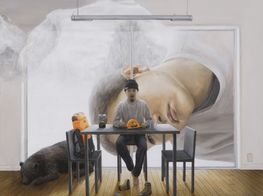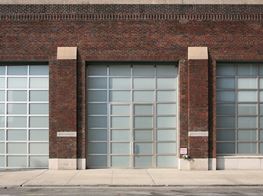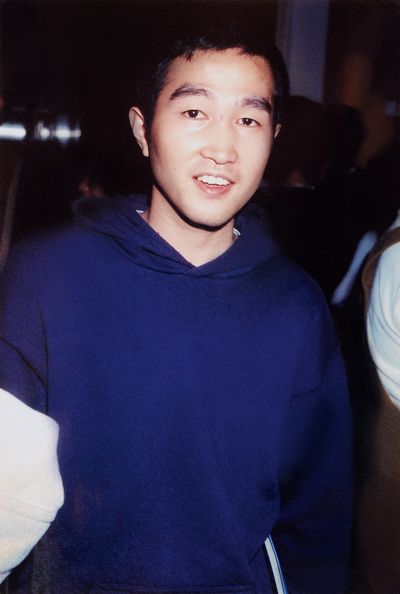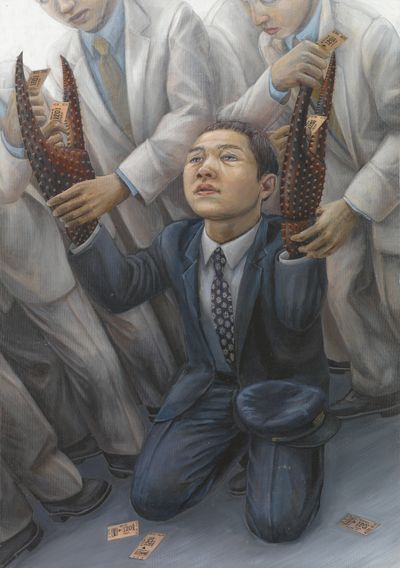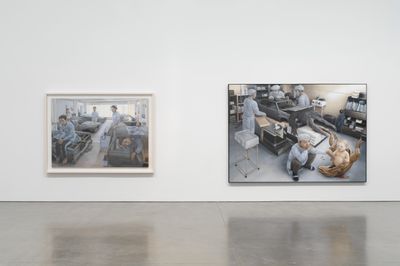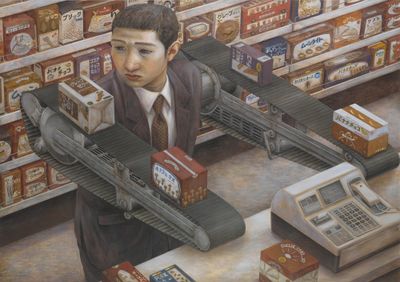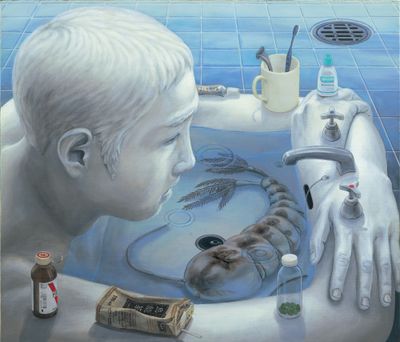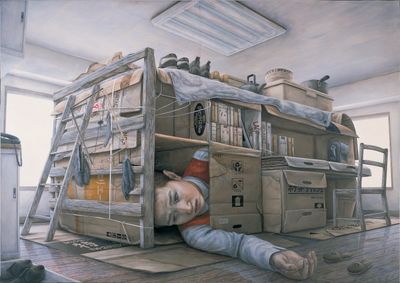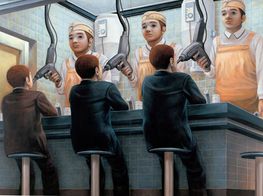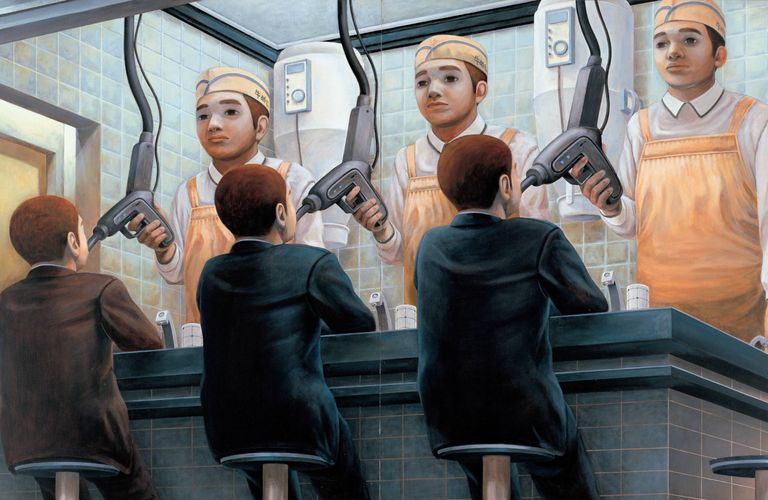
Tetsuya Ishida's Paintings Voice a Generation's Anxieties
Rediscovered on the international stage over the last decade, Tetsuya Ishida's surrealist paintings and drawings voicing the emotional turmoil of Japanese young men from the 'Lost Decade' remain just as relevant to society today.
The recession that lasted throughout the 1990s saw individuality stripped in favour of robotic subservience, and hikikomori, or 'shut-ins', locking themselves away in fear of the daily grind. Ishida's stark imagery of conveyor belts in lieu of hands and lifeless, suited, young men boxed up in their childhood bedrooms paints a picture of the hopelessness and isolation experienced by a generation.
Following the announcement of Gagosian's global representation of the Tetsuya Ishida Estate, the gallery is now host to My Anxious Self (12 September–21 October 2023) at 555 West 24th Street, New York.
On this occasion, Senior Director of Gagosian in Asia Nick Simunovic and curator Cecilia Alemani sit down with Ocula Director Rory Mitchell to discuss how the Gagosian show came together, Ishida's draw to social justice from a very early age, and the artwork's reception in New York.
When did you first come across Tetsuya Ishida's work?
NS: I was introduced to Tetsuya's work more than 12 years ago through a Hong Kong collector who owned a number of wonderful examples. I was immediately taken with the work and showed it to Larry, who was equally captivated. We both agreed that it would be interesting to present an exhibition and, as we didn't know the family at the time, we began making plans to mount a show of work from the secondary market. We secured great loans from collectors across Asia and the exhibition opened in November 2013.
That exhibition sparked a chain of events that was quite remarkable. Jessica Morgan, who was then a curator at Tate Modern, saw the exhibition and was so taken with the work that she included the artist in the 2014 edition of the Gwangju Biennale in South Korea, where she was artistic director.
Okwui Enwezor saw the work and was fascinated by Ishida and the power of his art and, in turn, featured the artist in his exhibition for the 56th Venice Biennale in 2015. The curatorial team of the Reina Sofia in Spain saw Okwui's exhibition in Venice and was so moved that they offered the family a solo exhibition, which opened in 2019. That show then travelled to Wrightwood 659, an exhibition space in Chicago.
In the years following the 2013 exhibition, we continued to work with the artist's material, but the watershed moment came when I was contacted by the Ishida family. They were aware of the efforts we had been making and they asked to meet. I met with Tetsuya's older brother in Hong Kong and then met more of the family at the Reina Sofia opening in Madrid in 2019. We slowly began building a relationship and we were given works for sale, which we placed in esteemed collections around the world.
At that time, we also began working towards a major exhibition in New York, which was something Tetsuya always wanted. Covid-19 slowed our plans a bit, but everything came together for the presentation this fall.
Ishida made over 200 paintings in his short career. Where are most of these works now?
NS: The Shizuoka Prefectural Museum of Art in Tetsuya's hometown in Japan has an incredible assemblage of his work and we are privileged to have important loans from their collection in our exhibition. Works are also in esteemed institutional and private collections in Asia and other parts of the world, and the Ishida Estate retains a significant number of his paintings as well.
Ishida began making paintings in the middle of the 'Lost Decade' of the 1990s; a time of mass unemployment in Japan. How was his work received in Japan during this period?
NC: Tetsuya received little recognition in Japan for his art during his brief lifetime. His work wasn't introduced to a larger audience until the year after his death when three galleries in Tokyo held simultaneous exhibitions in his memory, and Japanese broadcasters NHK dedicated a New Sunday Museum of Art segment to him.
While Ishida's paintings often depict hikikomori, young Japanese men who became recluses amid this 'Employment Ice Age', the themes of isolation, increasing dependency on technology and the mundanity of working life can all be recognised globally. I know that the Reina Sofia in Madrid recently staged a solo exhibition but why do you think it has taken a while for his work to be exhibited more widely in Europe and the US?
NS: It can be incredibly difficult for artists to receive the recognition they deserve. For Gagosian, there is no greater success than bringing visibility to a talented and underrepresented artist and helping to place their work in important private and institutional collections. Our journey with Tetsuya began more than 12 years ago and it has been one of the most rewarding experiences of my career. We have always believed in his work and felt it was extremely important that it be seen and understood in the West.
How has this show been received in New York?
Not at all surprisingly, Tetsuya's work has found a very receptive audience in New York. The profound humanity of his paintings addresses themes that are not only universal—disconnection, alienation and despair—but speak to the exact age in which we live. In some respects, his acknowledgment of the impact of machines and technology resonates and feels more urgent now than in the late 1990s when the works were first made.
Cecilia, your catalogue essay for the show mentioned that Ishida was greatly influenced by Ben Shahn's illustrations after visiting an exhibition in Tokyo, Lucky Dragon: Projection on a Hill in 1996. Could you tell us a bit more about this social context in relation to his work, which at times feels quite social realist in its approach.
CA: Tetsuya Ishida was drawn to social justice from a very early age. He got to know the work of American painter Ben Shahn early on, when he visited an exhibition of his work in Tokyo. Ben Shahn had illustrated, in paintings and drawings, a devastating accident that happened back in 1954, when a Japanese fishing boat called the Lucky Dragon was caught in the nuclear cloud produced by the American hydrogen bomb test in the Bikini atoll.
One fisherman died and many were injured. The boat had departed from Yaizu, the same town where Ishida was born, and this accident reverberated internationally. Ben Shahn, who was very vocal about his anti-nuclear commitment and position, depicted this tragedy in several works starting in 1958.
Ishida was very familiar with this tragedy, which affected his own community, and he wrote about it, in an essay he submitted to a school contest when he was only eight years old. He wrote: 'From there, the entire body became sick and suffered. The nuclear testing caused hair to fall out and blood loss. They were in pain and could not get up to go to work. It's really a tragedy. Why would humans use H-bombs to kill each other?'. He later wrote in his diary: 'I wanted to be like Ben Shahn.'
While his style evolved to become absolutely his own unique voice, the subject matter of Ishida's work—the desperation of Japanese society in the 1990's, the isolation of the youth, and the economic stagnation—resonates with Shahn's interest in portraying the social injustices that arises in the post war period.
There is also an obvious influence from Surrealism and more stylised aesthetics. Would these influences have come from Japanese artists or was Ishida also aware of things further afield?
While at the Musashino Art University in Tokyo, he was extremely influenced by outsider art and the exhibition 'Parallel Visions: Modern Artists and Outsider Art', held in 1993 at the Setagaya Art Museum in Tokyo.
It introduced major works by marginalised, mentally ill, self-taught, and visionary artists including Antonin Artaud, Henry Darger, Howard Finster, Madge Gill, Friedrich Schröder-Sonnenstern, August Walla, Adolf Wölfli, and Joseph E. Yoakum, among others. Completely taken with outsider art and the idea of originality, Ishida came to idealise it as the true original art form.
Tell us about the show at Gagosian in New York. Are there works from throughout his oeuvre? Do you see much change or progression across this ten year period of activity?
NS: The exhibition presents a significant portion of Tetsuya's entire output, creating a rare opportunity for collectors to encounter his extraordinary oeuvre. On view are nearly 80 works, which is a staggering number in relation to his entire output of about 200 paintings.
The exhibition is organised into five rooms, which are roughly chronological. As you walk through the space, subtle progressions such as colour palette and compositions are noticeable. For example, his later works have a deeper colour palette and he starts to incorporate female figures a bit more.
His painting The Men On A Belt Conveyor (1996), sold for just over U.S. $1 million (including buyer's premium) last year at Sotheby's in Hong Kong. Where do you see the market for Ishida going in the next few years?
NS: Tetsuya has had a devoted following for many years. And because of what our 2013 exhibition started, and the work we have done with the estate in recent years, we have built a robust list of global collectors who are eager to acquire his works. The New York exhibition will undoubtedly build on those efforts and increase his visibility. We are confident the interest in his work will only continue to grow.
Main image: Tetsuya Ishida, Refuel Meal (1996). Acrylic on board, in 2 parts. Overall: 145.6 × 206 cm. © Tetsuya Ishida Estate. Courtesy the artist, Shizuoka Prefectural Museum of Art, and Gagosian.

